

Preventive maintenance compliance PMC score measures how well your team completes scheduled preventive maintenance tasks on time.
The general goal is to achieve a PMC score of 90% or higher, which is a widely accepted industry standard for reducing downtime, improving safety, and increasing overall efficiency.
A high PMC rate (90% or above) reduces equipment failures and costly downtime.
Use a clear pm schedule, effective communication, and preventive maintenance software like Fabrico CMMS to improve compliance.
Features like mobile-first interfaces, QR codes, and real-time work order tracking simplify task completion and reporting.
Regularly review your preventive maintenance strategy and use data-driven insights to optimize your program.
Begin with an understanding of preventive maintenance compliance (PMC) as a crucial piece of your maintenance strategy. PMC is the percentage of scheduled preventive maintenance tasks completed within a defined timeframe for each piece of equipment or asset. The PMC score is the key metric for measuring compliance and evaluating maintenance performance.
To calculate pm compliance, divide the number of completed pm tasks by the total number of scheduled tasks within the specific timeframe, then multiply by 100 (x 100) to express the result as a percentage. This process is known as calculating pm compliance.
By tracking completed preventive maintenance tasks and your pmc score, you can identify gaps in your maintenance program, reduce reactive maintenance, and extend the lifespan of your critical equipment.
Reduced downtime: Completing preventive maintenance tasks on time prevents unexpected equipment failures, directly reducing downtime and keeping operations running smoothly.
Fewer breakdowns: High preventive maintenance compliance leads to fewer breakdowns, improving reliability and minimizing disruptions.
Cost savings: Avoid costly repairs and replacements by catching issues early, and reduce the need to fix equipment after breakdowns. Preventive maintenance is more cost-effective than fixing equipment reactively.
Improved equipment performance: Regularly serviced equipment performs better, ensuring machines run at peak efficiency and reliability.
Better resource allocation: Focus your maintenance team on tasks that matter most, and maintain control over maintenance schedules to optimize performance.
Audit readiness: Demonstrate compliance during regulatory and safety audits.
Early identification of potential problems: Regular maintenance helps identify potential problems before they escalate into major issues, allowing for timely intervention.
On-schedule maintenance turns: Ensuring each maintenance turn is completed on schedule is essential for compliance and reliability.
Many companies relies on effective maintenance to ensure smooth operations and reduce operational risks.
Achieving high PMC allows companies to realize the full benefits of preventive maintenance, including long-term cost savings, improved equipment performance, and reduced operational disruptions.
Use this simple pm compliance formula:
(Number of completed PM tasks ÷ Number of scheduled PM tasks) × 100 = PM Compliance Percentage.
To calculate your PMC score, divide the number of completed pm tasks (that is, completed preventive maintenance tasks finished within the scheduled timeframe) by the total number of scheduled preventive maintenance tasks for a specific period, such as a month or day, then multiply by 100 (x 100) to get the percentage.
Only completed preventive maintenance tasks that are finished within the scheduled timeframe are counted toward the PMC score. Tasks that occur outside the scheduled timeframe (late completions) are not included in the calculation.
A general industry goal is to achieve a PMC score of 90% or higher, which is considered good for most organizations.
For example, if you have 100 scheduled pm tasks for the month and 90 completed pm tasks (each piece of equipment is counted) are finished on time, your PMC score is 90%.
Note: The pm compliance formula does not consider the importance of each task or if delays occur frequently, so it should be used alongside other maintenance metrics for a complete picture.
Effective cost management is at the heart of a successful maintenance program. By focusing on preventive maintenance as a core strategy, companies can significantly reduce the risk of unexpected breakdowns and the high costs associated with emergency repairs. Prioritizing regular maintenance not only helps avoid costly downtime but also leads to better equipment performance and longer asset life.
To optimize costs, organizations should identify areas where maintenance spending can be streamlined without sacrificing reliability. Leveraging a CMMS provides valuable insights into maintenance activities, helping companies track expenses, monitor asset health, and pinpoint opportunities for improvement. With data-driven decision-making, maintenance teams can allocate resources more efficiently and ensure that every dollar invested leads to measurable performance gains.
Ultimately, a well-structured maintenance program that emphasizes preventive care will lead to lower overall costs, improved asset reliability, and a stronger bottom line for the company.
Many organizations encounter persistent challenges when trying to implement effective maintenance strategies. Limited resources—such as budget constraints, insufficient personnel, or outdated equipment—can make it difficult to keep up with both preventive and reactive maintenance tasks.
This often results in a backlog of work, which can negatively impact equipment performance and increase the risk of failures.
Another common issue is the struggle to balance preventive maintenance with urgent repairs. When reactive tasks take priority, preventive maintenance may be delayed or overlooked, leading to more frequent breakdowns and higher long-term costs.
In addition, maintaining accurate records and tracking all maintenance activities can be a daunting task, especially without the right tools in place.
To address these challenges, companies should establish clear goals for their maintenance program, invest in training for maintenance personnel, and implement strategies that prioritize preventive maintenance.
Utilizing a maintenance management system can help streamline task scheduling, improve record-keeping, and ensure that critical areas receive the attention they need. By proactively tackling these obstacles, organizations can enhance maintenance compliance, reduce risk, and boost overall equipment performance.
Define all preventive maintenance tasks with clear instructions, ensuring that preventive maintenance schedules cover every piece of equipment.
Set realistic frequencies based on manufacturer recommendations and historical data, and make sure each maintenance turn is clearly defined in the schedule.
Assign tasks to specific technicians.
Equip your team with Fabrico CMMS’s mobile app.
Technicians can scan asset QR codes to instantly access maintenance history and instructions.
Real-time work order tracking keeps everyone updated.
Manage maintenance tasks on the go—even while you travel—ensuring productivity and accessibility anywhere.
Focus on assets that impact safety and production the most.
Use downtime analysis tools in Fabrico CMMS to identify bottlenecks.
Provide regular training on maintenance procedures and software use.
Communicate the importance of completing tasks on or before the scheduled due date.
Use Fabrico’s dashboards to monitor pm compliance rates.
Identify trends and recurring issues to adjust your pm strategy.
Streamline tasks to reduce time and complexity.
Remove unnecessary or redundant maintenance activities.
Schedule dedicated time slots for pm work to avoid conflicts with reactive maintenance.
Audits and compliance play a vital role in ensuring that a maintenance program meets both regulatory requirements and industry best practices. Maintenance compliance PMC is a key indicator of how well an organization adheres to its preventive maintenance schedule, directly impacting asset health and equipment performance.
Regular audits help companies monitor their maintenance compliance PMC, identify gaps in their maintenance strategy, and address any deficiencies before they lead to larger issues.
Accurate documentation of maintenance activities is essential—not only does it provide proof of compliance during audits, but it also supports ongoing monitoring and long-term improvements.
By making audits and compliance a priority, organizations can avoid costly fines, reduce downtime, and ensure the safety and reliability of their operations. Continuous monitoring and timely adjustments to the maintenance program allow companies to close compliance gaps, implement long-term solutions, and maintain a high standard of asset care.
Ultimately, a strong focus on preventive maintenance compliance leads to better performance, fewer unexpected breakdowns, and a healthier bottom line.
Jane, a technician at a manufacturing plant, receives a daily list of completed pm tasks scheduled for that specific timeframe on her Fabrico mobile app. She scans the QR code on a machine, reviews the maintenance checklist, ensures each machine is properly serviced, completes the task, and updates the work order—all from her phone. Her supervisor monitors her progress in real-time and can quickly reassign tasks if needed. This streamlined process helps Jane complete tasks on time, boosting the plant’s PMC rate.
Q1: What is a good preventive maintenance compliance score?
A: A PMC score of 90% or higher is generally considered good across industries. Achieving this level allows companies to realize the full benefits of preventive maintenance, such as reduced downtime and improved equipment reliability. To calculate your PMC score, divide the number of completed preventive maintenance tasks by the total scheduled tasks, then multiply by 100 (x 100) to get the percentage.
Q2: How often should preventive maintenance tasks be scheduled?
A: Frequency depends on equipment type, manufacturer recommendations, and historical performance data. In general, tasks should be scheduled based on the number of days between maintenance cycles to ensure timely completion.
Q3: Can preventive maintenance software improve compliance?
A: Yes, tools like Fabrico CMMS make scheduling, tracking, and reporting easier, increasing task completion rates. They also help document completed preventive maintenance tasks for audits and performance analysis.
Q4: What happens if pm tasks are completed late?
A: If tasks occur outside the scheduled timeframe, they may not count toward compliance. Late tasks can increase the risk of equipment failure. The 10% rule suggests completing tasks within 10% of the scheduled due date for optimal results.
Mobile-first interface: Access maintenance schedules and update tasks anywhere.
QR code scanning: Quickly pull up asset info and maintenance history.
Work order tracking: Real-time visibility into task progress and delays.
Downtime analysis: Identify and address bottlenecks with data-driven insights.
Easy reporting: Generate compliance reports for audits and management.
Try Fabrico CMMS for free and see how easy it is to improve your preventive maintenance program, reduce downtime, and keep your operations running smoothly.
Register for free to experience the full capability of Fabrico - Start Your Free Trial Today!
